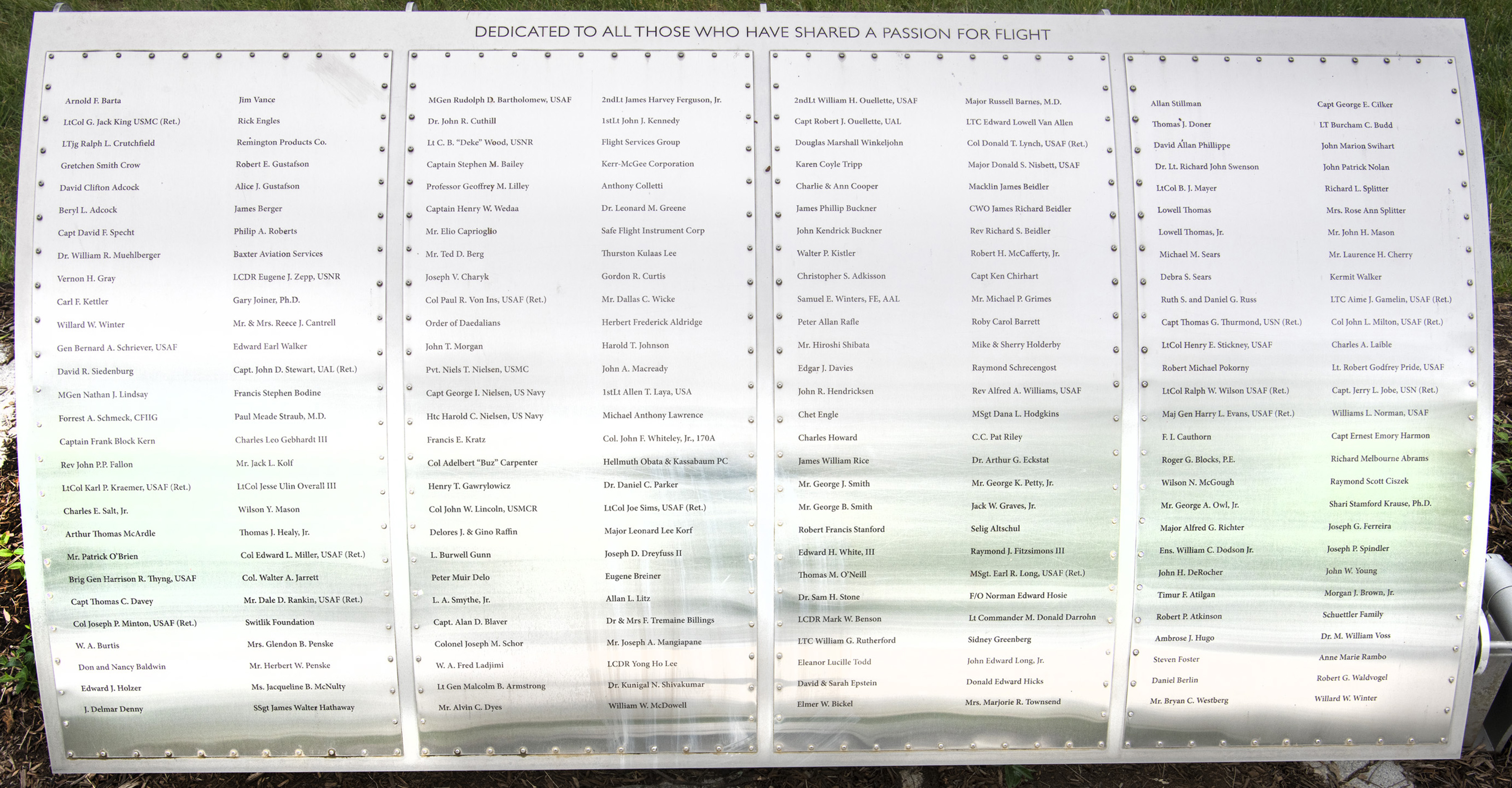
Foil: 26 Panel: 2 Column: 2 Line: 13
Wall of Honor Level: Air and Space Sponsor
Honored by:
Ms. Sally Macready Wallace
Pictured with the high altitude instruments used in his test flights, John Macready (1887-1979) was born in San Diego, CA. He graduated from. Stanford Univ. (1912) and enlisted in the U.S. Air Service in 1918.
He was Chief Test Pilot for the U.S. Air Service from 1920 - 1927 at McCook Field, Dayton, Ohio.
He attained an altitude record of 40,800 feet in the open cockpit LePere LUSAC-11 biplane in 1921 during high altitude testing of the turbo supercharger.
He held the World Altitude, Endurance and Distance Records simultaneously as Chief Test Pilot.
Macready made the First Non-Stop Flight across the United States in 1923. was the first crop duster (1921) and is still the only three-time winner of the Mackay Trophy for outstanding aviation achievement (1921, 1922, 1923).
He is enshrined in the Aviation Hall of Fame, Dayton, Ohio and the International Aerospace Hall of Fame, San Diego, CA 1976
80th Anniversary of the
First Non-Stop Transcontinental Flight
2003 is the eightieth anniversary of the first non-stop coast-to-coast flight from Long Island, New York to San Diego, California on May 2-3,1923.
The flight took 26 hours, 50 minutes and 38 seconds. It traveled 2,470 mites and averaged 92 mph. The aircraft was the Fokker T-2, a single engine monoplane. The pilots were Lt. John A. Macready and Lt. O. G. KeHy, U.S. Army Air Service.
This historic flight is the benchmark of our nation's centennial anniversary of aviation. It forever changed the way we were to travel, proving the feasibility of coast-to-coast flying, creating commercial aviation and military air power. Airports were built, air and mail routes established, and companies began building aircraft capable of transporting passengers and materials from one coast to the other in an incredibly short space of time.
The trans-continental flight began at t2:36 pm, May 2 when the T-2 took off from Roosevelt Field. Long Island, New York. The T-2 had a gross weight of 10,850 pounds, only 150 pounds less than the no margin limit for takeoff. The aircraft had been reconfigured to hold the 725 gallons of fuel needed for the flight. It was twenty minutes before the aircraft gained any altitude. Each pilot would fly in six hour shifts with the primary cockpit being open and just behind the noisy liberty engine. Severe storms and rains were encountered during the long periods of night flying.
"We crossed the continent without landing, flew in darkness for 13 Vk hours, experienced very bad weather, and flew without any sleep," stated Macready. "With a limited amount of fuel, straying off course would cause us not to reach the west coast. There were no railroads established, nor air or mail routes to follow. When we emerged from the storms and darkness, we were right on course using only our compass and knew we had enough fuel to reach San Diego. We take great pride in that feat of navigation."
When the T-2 arrived in view over San Diego, many aircraft went airborne to greet the two brave aviators, Macready and Kelly. A large crowd gathered as the T-2 landed at Rockwell Field, Coronado, California at 12:26 PST, May 3. The flight had captured the attention of all America and the world. The history making flight made front page headlines, including the New York Times.
"Accept my cordial congratulations on the success of your record breaking nonstop, coast-to-coast flight. You have written a new chapter in the triumphs of American aviation."
President Warren Harding
“The impossible has happened."
General "Hap" Arnold
"Heartiest congratulations on your great feat. Your flight is a milestone in the development of commercial aviation. In ten years the route you conquered and flew will be covered by passengers and freight service."
Anthony Fokker President,
Fokker Airlines
Developer of the T-2 aircraft.
The T-2 was flown to Washington, DC., where it is prominently exhibited today at the Smithsonian Air and Space Museum.
The pilots were awarded the Distinguished Flying Cross for the most meritorious flight of the year. Macready went on to win the MacKay Trophy a third time, still, to this day, the only individual so honored in the history of aviation.
"Honor is its own reward. There is plenty of glory in connection with flights of this nature, and considerable satisfaction in doing one's duty as a soldier and accomplishing a feat considered by many to be impossible."
John A. Macready
Aviator
Wall of Honor profiles are provided by the honoree or the donor who added their name to the Wall of Honor. The Museum cannot validate all facts contained in the profiles.
Foil: 26
